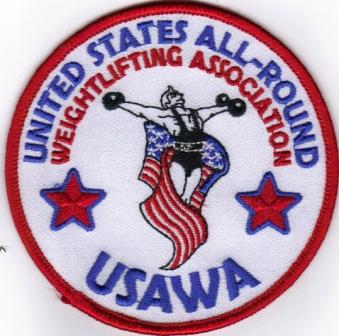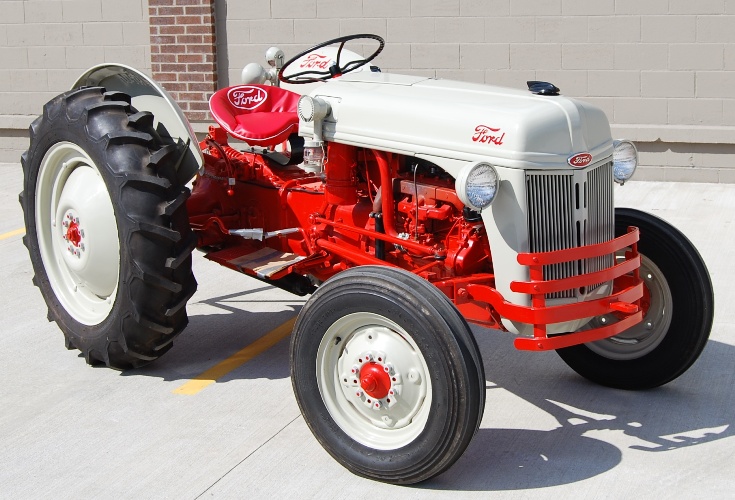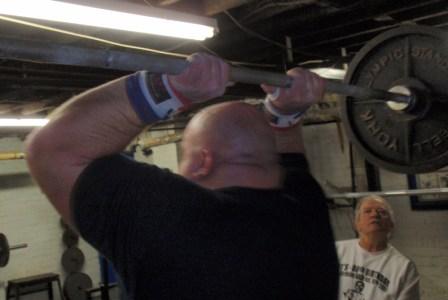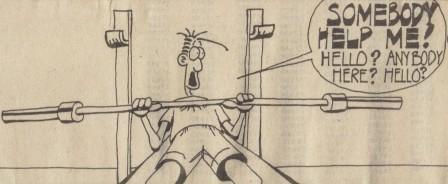by Dave Glasgow

Thom Van Vleck shortly after his childhood accident.
It was hard for me to imagine, when I first met him, the behemoth of a man standing in front of me, was once a skinny, frightened, wheel chair bound youth of 11. However, there he stood!! His story, although far from being finished, is an inspiration to us all and hopefully, a model for the youth of today.
Thom van Vleck started in the iron game, literally, by accident. A speeding car traveling in excess of 70 mph struck the bike riding youth; throwing him at least 150 feet, leaving him with multiple fractures, internal bleeding, head trauma and a prayer away from dying. The hospital he was transported to was certain there was nothing they could do for him. Fortunately, Thom’s mother “wanted a second opinion.” The second hospital was able to stabilize him and, eventually, turn him around. (Ironically, that hospital, the A.T. Still School of Medicine, in Kirksville, Mo., is the where Thom plies his trade as a clinical psychologist for the students that attend the school.)
Although he was alive, the outlook was bleak. There was talk of brain injury, impairment with ambulation…..the list went on. Little did those who prognosticated doom and gloom know that inside that broken and battered little body was the heart of a fighter. After nearly 4 months in traction and a year in a wheelchair, he was able to walk, with help. This was only the beginning.
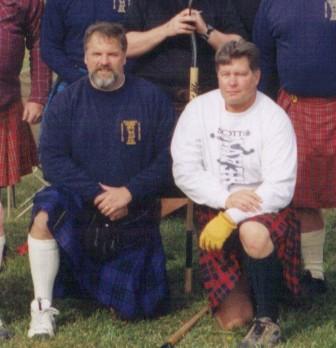
Thom Van Vleck (left) and Dave Glasgow (right) at the 2003 Galloway Highland Games in Kirksville, Missouri, which was promoted by Thom.
Luckily for Thom, he had a tremendous support system. A mother, who worked tirelessly; a grandfather, with an undying love and faith; two uncles, that were known for their strength and perseverance and the “big man” above. It would be the two uncles, Wayne and Phil Jackson, who introduced Thom to the wonderful world of weight training. They shared their love and passion for the iron and Thom was quick to grasp the idea that the weights could make him whole again.
Fast forward a few years, the trim, athletic boy became a man, courtesy of the United States Marine Corps. College and graduate school followed and he became the first in his family to gain an advanced degree. But, always, there were the weights. Everything from Olympic lifting, power lifting, to what he called his granddads “fruitcake” workouts, if there were weights involved, he was there. And, as before, his uncles were there to encourage, instruct and badger him to larger totals and loftier goals; be that in the iron game or life.
For those of us who know Thom, we know a man who is honest, trustworthy and, to use an overused phrase, genuine. What you see is what you get. No pretense. No agendas. He is thankful for his loving (dare I say, longsuffering!) wife and family. He is a student of the iron game and is constantly rubbing elbows with the elite of the weights and interesting folks that make up that vast world both past and present. His stories are interesting and engaging; his recollections spot on.
Thom has been active in just about every level of strength and weight training/lifting you can imagine. He has also transformed himself into a force to be dealt with on the Highland Games circuit. He has, also, organized outstanding competitions so that others could enjoy his passion with him.
It was at the McPherson highland games of ‘99 that I first saw Thom. I did not meet him as he was in the “youngster class” of A’s. It was not until the next ‘season’ that Thom and I were ‘introduced’! What an introduction!!
We were at Steve Scott’s north Kansas City recreation park doing one of the many games that Steve put on at that facility. Thom was judging the ‘geezer’ class of which I was a proud member. Although Steve had hammer cages, an errant #22 hammer of mine broke through the fencing and clocked Thom on the ankle. It went so far as to ‘tattoo’ his sock pattern into his ankle. It was not broken but, he was done for the day. I can safely say we have been friends since that day.
Thom is a rather complex guy. He ran, unsuccessfully, for state representative. He is an elder in his church. His work involves counseling students at the medical college in Kirksville. He is the former world record holder (age group) in the weight over the bar. And, as stated prior, he organizes strength contests and highland games throughout the year.
But, of all these things, he is proudest of the strength evangelism shows he puts on with the brothers Kerby and John O’Brian, all of Kirksville. Together, they have spread the gospel behind bone cracking demonstrations of skill and strength that never fail to make spectators ohh and ahh. Following one of Thom’s ‘mini’ shows at the McPherson Scottish Festival, a good friend of mine, who has traveled the world, looked at me, ‘pop-eyed’, and stated, “I have never seen anything like that before in my life!!” I might add, he is very hard to impress!!
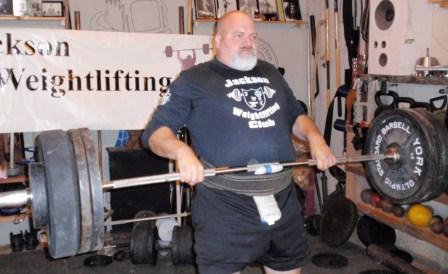
Thom Van Vleck set many USAWA records at the JWC Record Day, which he promoted last year at the JWC Training Hall on November 21st , 2009
Over the years, we have exchanged countless emails/phone calls and dined with each other every chance we got. It never ceases to amaze me his knowledge of people and events in the strength world. In these conversations there are three subjects that are ALWAYS mentioned. The weight game, his family and his faith! Not necessarily in that order.
Thom has no greater joy than that of his family. His wife, Kelly, supports his efforts and willing helps out at his competitions. She is a very special, understanding individual. He is thankful for her and has told me on more that one occasion how lucky he is to have someone such as her to allow him to pursue his interests. Rounding out this team is a daughter and two sons of whom he, rightfully, boasts on at any opportunity. And, from what I understand, the apples are not falling far from the giant tree!! The legacy of the Jackson/Van Vleck name will continue. I have NO doubt!
Oh, and one last thing. Thom is an author. He has written many, many articles for MILO. His forte is writing about the “old school” guys; John Ware, Al Feuerbach, Al Oerter,… the list goes on. He has the ability to bring these icons of throwing and strength down to a ‘human’ level and make them more like ‘everyday guys’ to us common folk.
He also writes, quite extensively, about the history of his family in the weight world and the proud tradition that has been passed down since 1928. These stories are a wonderful testament to a family legacy that continues today and, from all outward appearances, there is no indication that it will end anytime soon.
So, if you are ever in northern Missouri, have some time, you may want to make the trek to that big, two story house on the hill near Greentop. You may not know him at all, but that doesn’t matter. Just knock on the door, introduce yourself and you will leave with a new friend and a whole list of stories from the man with a truck load of them. Thom van Vleck, the multi-dimensional weight guy!
